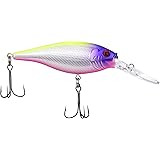The allure of a revolutionary fishing product is often irresistible, especially when social media feeds are flooded with seemingly miraculous catches. Anglers frequently encounter advertisements showcasing cutting-edge gear promising to transform their fishing experience. The video above delves into just such a phenomenon, putting a highly advertised robotic fishing lure to the ultimate test against real-world conditions and traditional methods. This deep dive aims to uncover whether these innovative, self-propelled baits are the future of fishing or merely another marketing gimmick designed to lighten an angler’s wallet.
The journey begins with an unboxing, revealing a product that initially looks promising. The robotic lure, available in both 3.5-inch and 5-inch models, is designed to mimic natural baitfish like shiners or fallfish with remarkable visual fidelity. It features multiple joints, small hooks at the back, larger hooks at the front, and even a propeller to facilitate its advertised lifelike swimming action. However, the excitement quickly turns to skepticism, particularly regarding its functionality in actual fishing scenarios versus its polished online presentation. Initial charging times for such devices typically range from two to three hours, which is a common investment for many rechargeable gadgets in the outdoor market.
The Robotic Lure: Unboxing and First Impressions
Upon receiving the electric bait, the initial impression is often one of hopeful anticipation. The particular robotic fishing lure examined came in two distinct sizes: a compact 3.5-inch model and a larger 5-inch version, both engineered to replicate the appearance of common baitfish like shiners. Equipped with multiple segments, a front propeller, and a combination of small and large treble hooks, the lure boasts a design intended for lifelike movement. These features are standard for many advanced artificial baits, yet the promise of autonomous swimming sets this product apart in the crowded fishing gear market.
The packaging of such lures frequently includes essential components like a charger and spare propellers, indicating a product designed for longevity and repairability. Charging these sophisticated devices is a common initial step, with an average charging duration often falling within the two to three-hour range, as noted for this specific model. This preparation period is a familiar routine for many tech-savvy anglers eager to try out their new acquisitions. However, the true test lies beyond the unboxing, transitioning from a static display of potential to active performance in varied aquatic environments.
From Instagram to In-Water Reality: Testing the Lure
The discrepancy between online advertising and real-world performance became glaringly apparent during the initial in-water trials. The smaller 3.5-inch robotic lure, which was meant to mimic a shiner, immediately encountered significant issues. Instead of the fluid, lifelike motion depicted in advertisements, the lure often became tangled with its own treble hooks, rendering it immobile or causing it to swim erratically, resembling a creature with “mad cow disease.” This unexpected behavior led to immediate frustration, highlighting a critical flaw in its design or execution when interacting with actual fishing lines and current.
Despite attempts to rectify the issue, including adjusting bobber placement and trying different casting techniques, the smaller lure consistently failed to perform as advertised. The hooks, while crucial for catching fish, frequently fouled the propeller or the line itself, creating a frustrating experience. This initial failure suggested a significant disconnect between the product’s marketing claims and its practical application. The investment of approximately $30 for a single lure, and potentially more when purchasing multiple sizes or models, quickly felt like a regrettable expenditure given its poor performance.
Transitioning to the larger 5-inch robotic lure, there was a slight improvement in its swimming action. While still not perfectly emulating a live fish, its movements were less prone to immediate entanglement. This larger model, resembling a substantial swimbait, offered a glimmer of hope that the design might scale better, or perhaps its increased size provided more stability in the water. However, its performance still fell short of the autonomous, natural swimming depicted in promotional videos. The challenge remained in getting the lure to consistently execute its advertised function without manual intervention or constant re-casting.
Live Bait vs. Robotic Lure: A Direct Comparison
The stark reality of the robotic lure’s underperformance necessitated a direct comparison with traditional, proven methods, specifically live bait. While the robotic lure struggled to maintain a natural swim and consistently got tangled, its live counterpart—a real shiner—immediately yielded results. In the same fishing spot where the robotic lure failed to attract any interest, a live shiner quickly enticed a peacock bass. This rapid success underscores the inherent advantage of live bait, which possesses natural movements, scent, and texture that artificial lures, no matter how advanced, often struggle to replicate completely.
Live bait often triggers an instinctive strike response from predatory fish, a phenomenon well-documented in fishing studies. The natural struggle and distress signals emitted by live prey are powerful attractants that can override a fish’s wariness. While some sophisticated artificial lures achieve remarkable realism, few can fully replicate the complex sensory cues of live bait. The contrasting outcomes in this experiment—no fish on the robotic lure versus immediate success with live bait—provide compelling anecdotal evidence of the persistent efficacy of traditional methods, particularly when a technological innovation falls short of its ambitious promises.
The Debate: Is Live Bait Cheating?
The use of live bait often sparks a lively debate within the angling community regarding fairness and skill. Some purists argue that utilizing live shiners or similar bait constitutes “cheating” because it minimizes the challenge and skill required to entice a bite. They contend that the true art of fishing lies in mastering the presentation of artificial lures, understanding fish behavior, and tricking fish into striking something unnatural. This perspective emphasizes the mental and physical challenge involved in outsmarting fish with inanimate objects, viewing it as a higher form of the sport.
Conversely, many anglers view live bait as a legitimate and effective tool, pointing out that its use is a long-standing tradition in various fishing cultures worldwide. They argue that successful live bait fishing still requires significant skill, including knowing where to find bait, how to keep it alive, and how to present it effectively. Furthermore, for those focused on the catch rather than the method, live bait simply provides the most direct and often most successful path to hooking a fish. Ultimately, the definition of “cheating” often comes down to individual philosophy and the specific rules of a particular fishing competition or location, underscoring the diversity of approaches within the angling community.
Rod Reliability and Unexpected Breakages
Beyond the lure experiment, an unexpected equipment failure occurred, highlighting the critical importance of reliable gear. A Bass Pro brand graphite Series R1 Granite rod, priced at approximately $35, snapped during a fight with a peacock bass. This incident occurred after only about two or three weeks of use, which is a surprisingly short lifespan for a fishing rod, even an entry-level one. The break was clean, suggesting a structural weakness or material fatigue under unexpected strain, particularly given the strong fighting nature of peacock bass.
The experience contrasted sharply with the angler’s previous positive encounters with Hey Skipper branded rods, which had withstood numerous catches of large fish without incident. This comparison naturally leads to questions about quality control and material science in fishing rod manufacturing. While an initial cost saving might seem appealing, a rod that fails prematurely can lead to lost fish, frustration, and ultimately, greater expense through replacement. This incident serves as a cautionary tale, emphasizing that investing in higher-quality, proven equipment can often prevent costly and disappointing failures on the water.
Freshwater vs. Saltwater Fishing: A Broadening Horizon
The fishing experience often begins in freshwater environments, offering a familiar and relatively predictable angling landscape. In freshwater, anglers typically target species such as bass, bluegill, or catfish, and their habitats are often confined to specific areas like lakes, rivers, and canals. This predictability, combined with fewer environmental variables like tides, often makes freshwater fishing feel more accessible and, for some, easier. Knowing general hiding spots and preferred structures can lead to consistent catches, making it a popular starting point for many enthusiasts.
However, the transition to saltwater fishing introduces a whole new dimension of challenges and excitement. The ocean, with its vastness and dynamic ecosystems, presents an almost limitless array of species to pursue, from powerful game fish to diverse bottom dwellers. The influence of tides, currents, and vast open spaces means that fish populations are constantly on the move, requiring different strategies and a deeper understanding of marine ecology. This complexity, while daunting, also provides an exhilarating sense of adventure, as each cast holds the potential for an entirely new and often larger species than typically found in freshwater systems.
Catch and Release vs. Harvest: Environmental and Health Considerations
The decision to practice catch and release versus harvesting fish for consumption is influenced by several factors, including personal ethics, conservation efforts, and environmental concerns. In many freshwater environments, particularly those in landlocked canals or urbanized areas, the quality of the water can be compromised by pollutants such as pesticides, herbicides, and industrial runoff. Fish caught in these locations may accumulate these chemicals in their tissues, making them potentially unsafe for human consumption. This is a primary reason why many anglers opt for catch and release in such areas, prioritizing the health of the ecosystem and their own well-being.
Conversely, fishing in expansive saltwater environments often presents a different scenario. The vastness of the ocean, combined with strong currents and natural dilution processes, generally leads to a lower concentration of localized pollutants in marine fish. Therefore, many anglers feel more comfortable harvesting and consuming fish caught in the ocean, viewing it as a tangible reward for their efforts. This practice not only provides fresh, natural protein but can also be seen as recouping some of the financial investment in gear and trips. The distinction between these environments highlights the importance of informed decision-making based on local water quality and species health, promoting responsible angling practices for both recreation and sustenance.
Ultimately, the journey through testing the robotic fishing lure, experiencing gear failure, and reflecting on broader fishing philosophies yields valuable insights for any angler. From the initial $120 investment in multiple robotic fishing lures, the outcome points strongly towards these being a gimmick, proving ineffective compared to time-tested alternatives like live bait. This firsthand experience reinforces the age-old wisdom that sometimes, the simplest and most natural approaches remain the most effective in the complex world of fishing. It highlights the importance of careful consideration and skepticism when new, highly advertised products emerge, urging anglers to question whether an expensive new gadget truly enhances the experience or merely drains the wallet.








